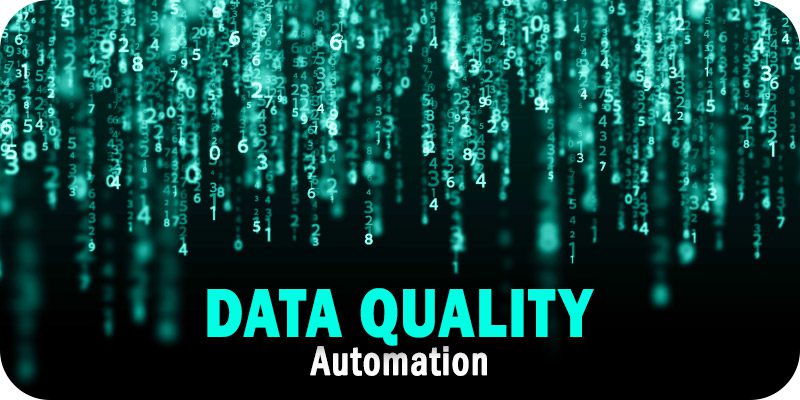Data Quality Automation: Does Automation Guarantee Quality?


This is part of Solutions Review’s Premium Content Series, a collection of contributed columns written by industry experts in maturing software categories. In this submission, Neutronian Co-Founder and CEO Timur Yarnall explores whether data quality automation equals fully automated data quality, or whether a nuanced approach is best.

Data plays a huge role in businesses, informing decisions on how they can increase sales, identify growth opportunities, and improve business operations. But the process of manually collecting all that data can often be challenging and tedious. Large amounts of employee time need to be dedicated to sifting through the ever-growing mountain of data being collected from different sources. The data must be correctly categorized, stored, and analyzed to be of any use to management decision-making. But even with all these difficulties, many businesses today are still hesitant to automate the data collection process, fearing that it won’t be as accurate as manual data entry.
The truth is that automating your data collection process can not only make it more streamlined, organized, and less labor-intensive, but also improve the quality of the data being collected. It achieves this by removing the potential for human error (spelling mistakes, accidental duplicates, incorrect data entries) and through AI programming that can flag unclear or unreadable data for review by a human.
But any automated data collection process is only as good as the system it works within. If too many errors are being flagged due to a faulty system, this can diminish the benefits of automation. Managers need to implement a rock-solid data collection system that can ensure better data accuracy from the beginning. Only then can they put their business on a secure footing that will enable them to grow and thrive in a data-rich future.
1. Measuring Data Quality
To ensure data accuracy, every business needs to first clarify what data quality means to them. Without clear standards, there is no way to determine if a piece of data is accurate or even useful. To yield quality data, consider the following five indicators:
- Accuracy – The recorded data should be correct and match the source document.
- Relevancy – The data should be relevant to its intended use.
- Completeness – There should be no missing values or incomplete records.
- Timeliness – The data should be up to date.
- Consistency – All the data should be recorded in the same format so that it can be easily indexed and categorized.
It’s worth noting that the standards can differ depending on the nature of the data and how it is to be used. For instance, data on your customer base might be more important to you than data on vendors or another third party. It’s up to each business to determine which datasets have the highest priorities for accuracy.
2. Ensure Rigorous Control of Incoming Data
Too many businesses focus on the final data and invest in efforts to ensure it is accurate once it enters a monthly report. They forget that most bad data comes from third-party sources outsides the control of the business. Once it enters the pipeline, it may become too time-consuming to determine where the error came from or too costly to fix the issue. A better approach is to ensure rigorous control of all incoming data to check for quality.
This can sometimes be a challenge as it is not always easy to verify the accuracy of data from an outside source. You can though make the process a little easier by setting strict data quality alerts on your automation system that can flag incomplete entries, value distributions and abnormalities, and inconsistent data formats. The sooner you can catch a problem before it enters the system, the less effort you will spend on trying to fix it.
3. Choose the Right Automation Tools
Automation can achieve wonders and there is an abundance of data collection tools out there that can save you time, flag inaccurate data entries, and ensure better data. But to get the most out of automation, you need to choose the right tools for the job. Conduct a detailed analysis to choose the right software based on the needs of your business and your data collection priorities. For example, at Neutronian, we aim to provide independent verification of data accuracy with a key focus on transparency and industry compliance. This can be a high priority for businesses in which ensuring compliance is crucial for avoiding hefty legal fines.
When selecting software tools for data collection, businesses should consider the following factors:
– Detailed testing to ensure it meets your needs.
– Whether your employees have the skill sets required to use the software.
– The licensing cost of the software.
4. Carry Out Regular Data Cleansing Audits
Maintaining data quality is a bit like looking after a vegetable garden: if you want good things to grow, then you need to regularly trim the weeds. Even the tiniest of errors or duplicated data can throw off your data by a wide margin. Regular data cleansing audits can root out errors and correct them, whether it’s removing useful data, filling in gaps, or correcting inaccurate entries. The more often you audit, the more confident you’ll be in your data quality.
An effective data audit typically requires three things:
- Bring in Stakeholders – Your data is likely stored across multiple departments. Invite all the key stakeholders to talk about data collection, storage, and use.
- Map Out Where the Data Is – Identify, locate, and chart where all your relevant data lives in your system. Note also how it is stored and who has access to it.
- Evaluate Based on Your Data Quality Standards – Perform an in-depth analysis to identify and correct any errors, formatting issues, or methodological problems.
Final Thoughts
Maintaining data quality is an ongoing process that requires strict standards, rigorous management, and proactive monitoring. Automation can certainly make the process a lot easier, but the human element is still required to ensure data quality. Data collection and quality control are far from easy tasks, but they’re ones that no business today can afford to ignore.























